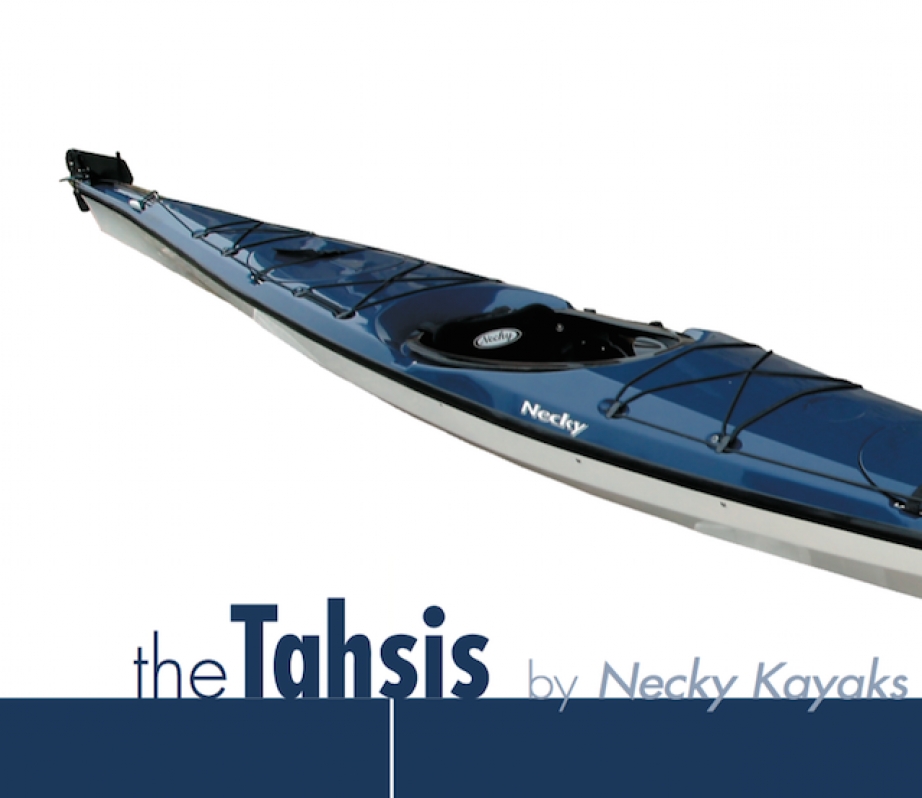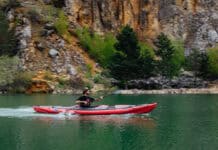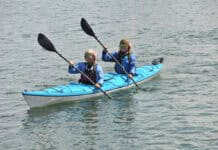I’ve been cruising around in my slim, 19-foot, long-distance touring boat for years. I’m so addicted to the speed of its torpedo lines that any standard-length kayak feels as sluggish as molasses. But the price I pay for speed and the stowage capacity of a small galleon is the sloppy fit of an echo-chamber cockpit and the turning radius of a Lincoln Town Car towing a sailboat. In the new Necky Tahsis I’ve found the ultimate combo—a multi-day touring kayak that’s as long, narrow and super fast as my expedition boat, with the snug fit and sporty performance of a day tripper.
At 18 feet long and 22 inches wide, the Tahsis is almost as streamlined as kayaks come. I was able to reach a max speed over 6.5 knots (12 km/h) and cruise effortlessly at four to five knots.
Necky Tahsis Specs
Length: 18 ft
Width: 22 in
Depth: 12 in
Cockpit: 32 x 15 in
Front hatch: 11.5 x 7.5 in
Rear hatch: 14.5 x 10.5 in
Weight: Fibreglass 60 lbs / Kevlar 55 lbs
MSRP: Fibreglass $2699 USD / Kevlar $3199 USD
Rudder: SmartTrack rudder system $199 USD /Titanium rudder $249 USD
Empty, the Tahsis is “sporty” or “tippy” depending on how comfortable you are in performance hulls, but that’s what allows it to crank so comfortably into a stable, radical tilt for an outside turn.
On a tilt you’re not only shortening the waterline but engaging several edges of the multi-chined hill. The chines act like arced keels to carve the boat with noticeably more oomph than a soft-chined hull. With no initiation from the paddle, I could zigzag the Tahsis through linked turns by rocking my hips from side to side. It’s like engaging a shaped ski on groomed powder.
I’ve never been so tuned into my hip action in a touring kayak, so I was grateful for a snug, performance fit. Only 1-foot-deep with a flat deck, the Tahsis has a low profile, low windage, and fairly small cockpit—no problem for long lanky frames and size 13 feet, but not a happy place for the big boned. This is a boat for wearing more than sitting in—think ski boots and climbing shoes. If the Tahsis were a wetsuit it would fit exactly my size: medium-tall.
With its long waterline and low profile, the Tahsis catches very little wind and weathercocks only mildly. In a moderate blow, I found the foot rudder wasn’t necessary at all, but it’s comforting to have the option on a long boat.
The standard rudder is sturdy and beautifully engineered with no sharp edges, with control lines that disappear into a channel below the deck. This refinement adds significant resistance when engaging the rudder but results in a clean appearance.
A fancy SmartTrack rudder system from Cascade Designs is optional. And if you’re planning to do a lot of rock garden ballet with your rudder down, the rugged titanium rudder option is for you.
The Tahsis is best suited for intermediate to advanced, smaller to medium-sized paddlers (tall ones too!) who want a snug performance boat with the speed and capacity of a long, narrow hull—ideal for multi-day tripping and weekend racing.
Cockpit (left)
Features that let you wear the boat: comfortable contoured thigh braces; ratchet-adjustable backband; and a padded seat cushion that inflates with a squeeze of the rubber bulb. Add hip padding to taste and you’re ready to surf and roll. Unique to the Kevlar layup (shown) are the black ribs of graphite and, interestingly, a spruce dowel moulded into the keel lines as a stiffener.
Hull (middle)
Mike Neckar’s “diamond” hull looks like a cut gemstone. It has six chines with a concavity along the keel between the bottom chines. In theory, the design improves stiffness and tracking, with the negligible side effect of sitting deeper in the water. In practice, the noticeable effect is its caving ability on edge.
Rear deck (right)
The Tahsis is as sleek as a submarine with recessed deck fittings and rudder controls. Necky calls their time-tested two-piece hatch system “the best of both worlds”—an underlying neoprene cover seals the hatch and the plastic outer cover sits flush with the deck, shedding waves and protecting the neoprene from UV. Expect to see different hatch designs in the future.
This article originally appeared in Adventure Kayak‘s Fall 2003 issue. Subscribe to Paddling Magazine’s print and digital editions here, or browse the archives here.









